A SP ARTE ( @sp_arte) chega ao seu vigésimo aniversário mais forte e madura, especialmente no design. Confira 5.000 obras de 2.000 mil artistas expostas na Bienal São Paulo ( @bienalsaopaulo ) encantando quem passa por lá.
Vem comigo descobrir alguns dos destaques de arte, Trarei aqui algumas obras que chamaram minha atenção. E depois me conta, o que você mais gostou.
SP ARTE (@sp_arte) reaches its twentieth anniversary stronger and more mature, especially in design.
Check out 5,000 works by 2,000 artists exhibited at the Bienal São Paulo ( @bienalsaopaulo ) enchanting those who pass by.
Come with me to discover some of the art highlights. I will bring here some works that caught my attention. And then tell me what you liked most.
+55 Design celebra 60 anos de carreira do renomado xilogravurista J. Borges em
coleção de móveis inéditos desenhados por Bruno de Carvalho
+55 Design celebrates 60 years of career of renowned wood engraver J. Borges in
collection of new furniture designed by Bruno de Carvalho
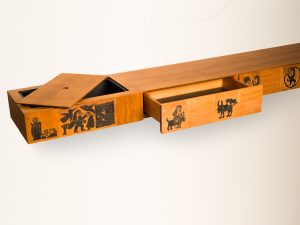
Em uma colaboração autoral, a +55 Design traz a produção do artista J. Borges, o maior cordelista e xilogravurista em atividade no Brasil, para a coleção Cordel: uma série de oito peças inéditas que combinam a mais bela expressão do fazer manual – o esculpir – à riqueza construtiva do processo industrial +55.
Revisitando seus mais de 300 folhetos de cordel ilustrados ao longo de 60 anos de trajetória, além de outros grandes clássicos nacionais, o artista e sua equipe selecionaram oito histórias marcantes para reinterpretar, representar e imaginar livremente sobre peças de mobiliário, assumindo o papel de revestimento destes. As gravuras inéditas criadas para o projeto perpetuam a produção do Mestre, historicamente reconhecida por reinventar e ressignificar o imaginário nordestino; um universo povoado por figuras encantadas, seres alados, animais, anjos, demônios, cangaceiros, vaqueiros, cantadores, entre outros tantos heróis populares, além do povo e sua resiliência.
In an authorial collaboration, +55 Design brings the production of the artist J. Borges, the greatest cordelist and woodcut artist active in Brazil, to the Cordel collection: a series of eight new pieces that combine the most beautiful expression of manual making – the sculpt – to the constructive richness of the industrial process +55.
Revisiting his more than 300 illustrated cordel leaflets over 60 years of history, in addition to other great national classics, the artist and his team selected eight striking stories to reinterpret, represent and imagine freely on pieces of furniture, assuming the role of covering of these. The new engravings created for the project perpetuate the Master’s production, historically recognized for reinventing and giving new meaning to the northeastern imagination; a universe populated by enchanted figures, winged beings, animals, angels, demons, cangaceiros, cowboys, singers, among many other popular heroes, in addition to the people and their resilience.

As matrizes esculpidas em madeira louro canela apresentam tamanhos modulares, permitindo arranjos em diferentes composições sobre as portas e gavetas dos móveis desenhados por Bruno de Carvalho, designer exclusivo da +55. Cinco das oito peças – entre aparadores suspensos, aparadores com pés e bares – serão carimbadas com pigmento preto, enquanto as outras três preservam o aspecto original e intacto da madeira entalhada.
The matrices carved in cinnamon blond wood have modular sizes, allowing arrangements in different compositions on the doors and drawers of the furniture designed by Bruno de Carvalho, exclusive designer at +55. Five of the eight pieces – including hanging sideboards, sideboards with feet and bars – will be stamped with black pigment, while the other three preserve the original and intact appearance of the carved wood.
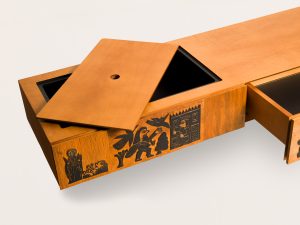
Depois de serem produzidas no ateliê de J. Borges em Bezerros, PE, as matrizes seguem diretamente para Campinas, SP, onde está localizada a fábrica da +55. Lá, são incorporadas aos móveis exclusivamente desenhados para o projeto pelo designer da casa, Bruno de Carvalho, que também é o responsável pela concepção do projeto como um todo – desde a ideia de combinar xilografia e indústria, passando pela modulação das matrizes e pelo desenho de mobiliário, até chegar à solução da expografia do stand.
A fabricação conta com o apoio de equipamentos e máquinas de última geração importados da Itália, em um espaço onde a marca +55 atua em todas as etapas de desenvolvimento, incluindo processos de marcenaria, serralheria e corte de couro. Com dobradiças e corrediças importadas da Itália, os móveis garantem qualidade superior em suas ferragens. Além disso, a materialidade do couro, tão emblemática na marca +55, também está presente, revestindo os interiores e complementando detalhes das peças.
After being produced in J. Borges’ studio in Bezerros, PE, the matrices go directly to Campinas, SP, where the +55 factory is located. There, they are incorporated into the furniture exclusively designed for the project by the house’s designer, Bruno de Carvalho, who is also responsible for the design of the project as a whole – from the idea of combining woodcutting and industry, through the modulation of the matrices and the design. of furniture, until arriving at the solution for the stand’s display.
Manufacturing is supported by state-of-the-art equipment and machines imported from Italy, in a space where the +55 brand operates in all stages of development, including carpentry, metalworking and leather cutting processes. With hinges and slides imported from Italy, the furniture guarantees superior quality in its hardware. Furthermore, the materiality of leather, so emblematic of the +55 brand, is also present, covering the interiors and complementing the details of the pieces.
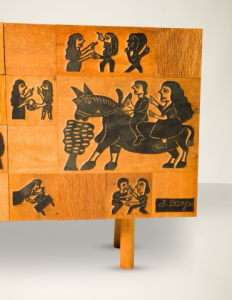
O moderno parque fabril é equipado com máquinas controladas por computação numérica, consolidando-se como referência nacional em tecnologia embarcada, com mão de obra especializada e qualificada. A operação é baseada principalmente no uso de madeira certificada – com selo internacional que garante responsabilidade socioambiental – e do couro como reaproveitamento de um recurso renovável e natural, proveniente de resíduos gerados por fazendas de abate de bovinos destinadas à produção de proteína animal.
Como forma de homenagear e prestigiar este ícone vivo da arte popular brasileira, a +55 trará J. Borges para a abertura da SP-Arte, exclusiva para convidados, a ser realizada no dia 3 de abril, quarta-feira.
The modern manufacturing park is equipped with machines controlled by numerical computing, consolidating itself as a national reference in embedded technology, with specialized and qualified labor. The operation is mainly based on the use of certified wood – with an international seal that guarantees socio-environmental responsibility – and leather as a reuse of a renewable and natural resource, coming from waste generated by cattle slaughter farms destined for the production of animal protein.
As a way of honoring and honoring this living icon of Brazilian popular art, +55 will bring J. Borges to the opening of SP-Arte, exclusively for guests, to be held on April 3rd, Wednesday.
Sobre J. Borges
About J. Borges
Foi através das histórias contadas na hora de dormir pelo pai agricultor que José Francisc Borges, o mestre J. Borges – artista popular autodidata, poeta, xilogravador, patrimônio vivo de Pernambuco (título outorgado pelo Governo do Estado) e pai de 18 filhos – enveredou pelo mundo da sonora e ritmada poesia de cordel. Nascido em 20 de dezembro de 1935 na zona rural de Bezerros, município do Agreste Central, seguiu a mesma sina dos meninos vindos de famílias pobres, trocando as brincadeiras da infância pelo trabalho. Durante a adolescência, agarrou todas as chances dadas pela vida: foi passador de jogo de bicho, pedreiro, carpinteiro, pintor de parede, oleiro, trabalhador da palha da cana de açúcar e vendedor, entrando no universo do Cordel com 21 anos – e através dele se tornando um dos artistas mais consagrados, com sua obra premiada e admirada em todo o mundo.
It was through the stories told at bedtime by his farmer father that José Francisc Borges, the master J. Borges – self-taught popular artist, poet, wood engraver, living heritage of Pernambuco (title granted by the State Government) and father of 18 children – embarked on through the world of sonorous and rhythmic cordel poetry. Born on December 20, 1935 in the rural area of Bezerros, a municipality in Agreste Central, he followed the same fate as boys from poor families, exchanging childhood games for work. During his adolescence, he took every chance given by life: he was a game passer, bricklayer, carpenter, wall painter, potter, sugarcane straw worker and salesman, entering the world of Cordel at the age of 21 – and through him becoming one of the most renowned artists, with his work awarded and admired throughout the world.
Em 1956, J. Borges se torna vendedor de cordéis (folheteiro), divulgando a literatura popular pelas feiras e praças públicas do interior de Pernambuco. Mas foi só em 1964 que ele escreveu o seu primeiro folheto, ‘O Encontro de Dois Vaqueiros no Sertão de Petrolina’, com capa ilustrada pelo mestre cordelista e xilogravurista Dila (1937-2019), outro patrimônio da cultura pernambucana. Após ótimo desempenho de vendas, o artista lançou no ano seguinte o seu segundo cordel, ‘O Verdadeiro aviso de Frei Damião sobre os Castigos que vêm’, agora ilustrado por ele mesmo com a técnica da xilogravura. Sua empreitada na xilogravura ganha projeção a partir dos anos 1970, quando começa a produzir, sob encomenda, as suas primeiras gravuras em grande formato com a temática do folclore nordestino, chegando ao conhecimento de nomes como Ariano Suassuna (1927-2014). “Soube que assim que ele viu as gravuras perguntou quem era a fera que fazia aquilo. Logo depois, fui chamado à Universidade Federal de Pernambuco para conhecê-lo e para dar entrevistas a meio mundo de jornalistas que ele tinha convocado. Depois dali eu não parei mais”, relembra J. Borges o começo da longa amizade que manteve com o escritor, que o considerava “o maior gravador popular do Brasil”.
In 1956, J. Borges became a cordéis seller (flyer), spreading popular literature through fairs and public squares in the interior of Pernambuco. But it was only in 1964 that he wrote his first leaflet, ‘O Encontro de Dois Vaqueiros no Sertão de Petrolina’, with a cover illustrated by the master cordelist and woodcut artist Dila (1937-2019), another heritage of Pernambuco culture. After excellent sales performance, the artist launched his second cordel the following year, ‘The True Warning of Frei Damião on the Punishments that Come’, now illustrated by himself using the woodcut technique. His work in woodcuts gained prominence in the 1970s, when he began to produce, to order, his first large-format engravings with the theme of northeastern folklore, becoming known to names such as Ariano Suassuna (1927-2014). “I knew that as soon as he saw the engravings he asked who the beast was that did that. Soon after, I was called to the Federal University of Pernambuco to meet him and to give interviews to half the world of journalists he had summoned. After that I never stopped”, J. Borges recalls the beginning of the long friendship he maintained with the writer, who considered him “the greatest popular engraver in Brazil”.
Prestes a completar 60 anos desde o lançamento de seu primeiro cordel, J.Borges já produziu 314 folhetos e um número incalculável de xilogravuras já expostas em diversos museus – como o Louvre (França e o de Arte Moderna de Nova York (EUA), sendo inclusive comparado a Pablo Picasso em reportagem do jornal New York Times (2006), que o intitulou como “gênio da cultura popular”. Atualmente, produz xilografias apenas sob encomenda, e dedica-se a oficinas para jovens e crianças em seu Memorial localizado em sua terra natal, transmitindo sua paixão pelo cordel e pela cultura popular nordestina.
About to complete 60 years since the launch of his first cordel, J.Borges has already produced 314 leaflets and an incalculable number of woodcuts already exhibited in various museums – such as the Louvre (France and the Modern Art Museum in New York (USA), being He was even compared to Pablo Picasso in a report by the New York Times (2006), which called him a “genius of popular culture”. Currently, he produces woodcuts only to order, and dedicates himself to workshops for young people and children at his Memorial located in his homeland, transmitting his passion for cordel and northeastern popular culture.
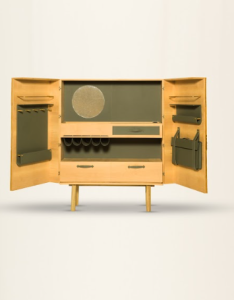
Sobre Bruno de Carvalho
About Bruno de Carvalho
Um dos nomes mais versáteis e criativos do design brasileiro contemporâneo, o paulista Bruno de Carvalho traz da sua formação em arquitetura a afinidade com a combinação de materiais inusitados e a execução artesanal, explorando o antagonismo de formas e
materialidades dentro de uma mesma peça. Em parceria com a +55 Design, sua marca autoral Decarvalho Atelier já conta com mais de 20 designs produzidos e comercializados com exclusividade pela +55.
One of the most versatile and creative names in contemporary Brazilian design, Bruno de Carvalho from São Paulo brings from his training in architecture an affinity with the combination of unusual materials and artisanal execution, exploring the antagonism of forms and
materialities within the same piece. In partnership with +55 Design, his signature brand Decarvalho Atelier already has more than 20 designs produced and sold exclusively by +55.
Sobre a literatura de Cordel e a Xilogravura
About Cordel’s literature and woodcuts
Dos gêneros literários mais tradicionais do Brasil, o movimento remonta suas raízes na Europa, durante o período do Renascimento no século XVI. Foi naquele momento que a imprensa surgiu, rompendo a tradição exclusivamente oral e cantada das narrativas. Os autores então começaram a expor suas obras pendurando os folhetos em cordões para a venda em feiras e mercados – e é dali que nasceu o nome “cordel”. A impressão em grande quantidade e rapidez de histórias curtas e regionais proporcionou sua rápida popularização, chegando ao Nordeste do Brasil junto com os portugueses ao longo do século XIX.
Of the most traditional literary genres in Brazil, the movement traces its roots back to Europe, during the Renaissance period in the 16th century. It was at that moment that the press emerged, breaking the exclusively oral and sung tradition of narratives. The authors then began to exhibit their works by hanging the leaflets on strings for sale at fairs and markets – and this is where the name “cordel” came from. The large and rapid printing of short and regional stories led to their rapid popularization, reaching the Northeast of Brazil along with the Portuguese throughout the 19th century.
A disseminação dos cordéis criados pelos poetas de bancada – aqueles que produziam os próprios folhetos, tanto texto e ilustração, de forma artesanal – foi amplamente impulsionada pelos repentistas – talentosos violeiros que divulgavam as histórias por meio da música e da oralidade a diversos vilarejos remotos. Essa simbiose entre a poesia impressa e a música improvisada contribuiu para o enraizamento dos cordéis na cultura brasileira, consolidando esta como uma forma acessível de entretenimento e informação, especialmente para aqueles com pouco acesso à educação formal. Com sua linguagem acessível e rimas cativantes, tornaram-se veículos essenciais na preservação dos costumes e tradições regionais, assumindo papel vital na criação e perpetuação do imaginário coletivo e folclórico local.
The dissemination of cordels created by bench poets – those who produced their own leaflets, both text and illustration, by hand – was largely driven by repentistas – talented guitarists who spread stories through music and orality to several remote villages. This symbiosis between printed poetry and improvised music contributed to the rooting of cordels in Brazilian culture, consolidating it as an accessible form of entertainment and information, especially for those with little access to formal education. With their accessible language and captivating rhymes, they have become essential vehicles in the preservation of regional customs and traditions, playing a vital role in the creation and perpetuation of local collective and folkloric imagery.
Em meio a isso, as técnicas de xilografia e xilogravura foram e são técnicas fundamentais para o cordel, utilizadas para produzir as imagens que acompanham os poemas impressos nos folhetos. Nesta técnica de ilustração, a madeira é entalhada para confeccionar imagens, transformando a área em relevo em carimbos, que são então utilizados para imprimir em série as ilustrações dos folhetos. Estas representações não apenas complementam as narrativas, enriquecendo a experiência do leitor ao dar vida aos poemas e histórias de fácil compreensão, como também consolidam uma estética única e uma identidade visual marcante à literatura, simbolizando as tradições artesanais. O cordel se consolida até hoje como uma expressão viva e pulsante da cultura brasileira, enraizada em suas origens e continuamente celebrada e apreciada por gerações, tendo em J. Borges a perpetuação viva de uma tradição secular.
In the midst of this, the techniques of xylography and wood engraving were and are fundamental techniques for cordel, used to produce the images that accompany the poems printed on the leaflets. In this illustration technique, wood is carved to make images, transforming the embossed area into stamps, which are then used to serially print the leaflet illustrations. These representations not only complement the narratives, enriching the reader’s experience by bringing easy-to-understand poems and stories to life, but they also consolidate a unique aesthetic and a striking visual identity to literature, symbolizing artisanal traditions. The cordel is consolidated to this day as a living and pulsating expression of Brazilian culture, rooted in its origins and continually celebrated and appreciated by generations, with J. Borges as the living perpetuation of a centuries-old tradition.
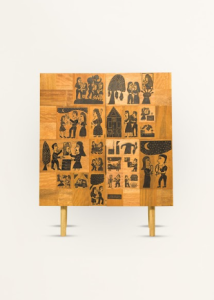
Conheça a coleção
Discover the collection
PEÇA 1 – ‘Coco Verde e Melancia’ | Aparador suspenso – 2 alturas
Medidas: 180L x 30A x 41P
Inspirada no Cordel ‘As Grandes Aventuras de Armando e Rosa conhecidos por Coco
Verde e Melancia’ (José Camelo de Melo, 1944)
Desde a infância, Armando e Rosa – apelidados de Coco-Verde e Melancia – cresceram juntos e se
apaixonaram profundamente. No entanto, o pai de Rosa, temendo a união dos dois, elabora uma
trama para separá-los, chegando ao extremo de fingir a morte de Armando. Desnorteado pela
falsidade, Armando parte, deixando Rosa em desespero. Anos se passam e ele retorna, decidido a
desvendar o engano e buscar o reencontro com seu verdadeiro amor.
PIECE 1 – ‘Green Coconut and Watermelon’ | Suspended sideboard – 2 heights
Measurements: 180W x 30H x 41D
Inspired by Cordel ‘The Great Adventures of Armando and Rosa known as Coco
Green and Watermelon’ (José Camelo de Melo, 1944)
Since childhood, Armando and Rosa – nicknamed Coco-Verde and Watermelon – grew up together and became
fell deeply in love. However, Rosa’s father, fearing the union of the two, prepares a
plot to separate them, going so far as to fake Armando’s death. Bewildered by
falsehood, Armando leaves, leaving Rosa in despair. Years pass and he returns, determined to
unravel the deception and seek a reunion with your true love.
PEÇA 2 – ‘Cidrão e Helena’ | Aparador com pés – 4 alturas
Medidas: 120L x 80A x 40P
Inspirada no Cordel ‘Cidrão e Helena’ (Severino G. de Oliveira)
Cidrão, um jovem destemido, é apaixonado por Helena, a filha de um barão. Quando ela é obrigada
pelo pai a se casar com outro homem, Cidrão parte em uma jornada arriscada para resgatá-la.
Enfrentando desafios e perigos, ele confronta o homem que a forçou a se casar e sai vitorioso:
Cidrão e Helena fogem juntos, iniciando uma nova vida livre do passado sombrio.
PIECE 2 – ‘Cidrão and Helena’ | Sideboard with feet – 4 heights
Measurements: 120W x 80H x 40D
Inspired by the Cordel ‘Cidrão and Helena’ (Severino G. de Oliveira)
Cidrão, a fearless young man, is in love with Helena, the daughter of a baron. When she is forced
by his father to marry another man, Cidrão sets out on a risky journey to rescue her.
Facing challenges and dangers, he confronts the man who forced her to marry and emerges victorious:
Cidrão and Helena run away together, starting a new life free from the dark past.
PEÇA 3 – ‘João e a Princesa’ | Aparador com pés – 3 alturas
Medidas: 180L x 80A x 40P
Inspirada no Cordel ‘Romance de João Cambadinho e a princesa do reino de Mira-mar’
(Inácio Carioca, 1932)
Em um reino encantado, o jovem João Cambadinho vive sob a tirania de sua madrasta e sua filha.
Enquanto tocava sua viola em um dia de pastoreio, ele é abordado pela misteriosa voz da princesa
Rosina, que fora amaldiçoada por uma feiticeira. Em seus encontros secretos numa lagoa, Rosina
traz refeições fartas e deixa sinais para João encontrá-la em seu reino. João então parte em uma
jornada, guiado por diversos animais, para libertá-la do feitiço e conquistar seu amor. Depois de anos, ele enfim chega ao Reino de Mira-mar, onde prova seu valor para o rei Baltazar e casa-se com
a princesa.
PIECE 3 – ‘John and the Princess’ | Sideboard with feet – 3 heights
Measurements: 180W x 80H x 40D
Inspired by Cordel ‘Romance by João Cambadinho and the princess of the kingdom of Mira-mar’
(Inácio Carioca, 1932)
In an enchanted kingdom, young João Cambadinho lives under the tyranny of his stepmother and daughter.
While playing his viola on a herding day, he is approached by the mysterious voice of the princess
Rosina, who was cursed by a witch. In their secret meetings in a lagoon, Rosina
She brings rich meals and leaves signs for John to find her in her kingdom. João then leaves on a
journey, guided by different animals, to free her from the spell and win her love. After years, he finally arrives in the Kingdom of Mira-mar, where he proves his worth to King Baltazar and marries
the princess.
PEÇA 4 – ‘Camões’ | Aparador suspenso – 1 altura
Medidas: 240L x 15A x 41P
Inspirada no Cordel ‘As Perguntas do Rei e as Respostas de Camões’ (Severino G. de
Oliveira)
Desde jovem, Camões demonstra inteligência diferenciada, profetizando o futuro e intrigando a todos
ao seu redor. Ele é então desafiado pelo rei a responder uma série de 30 charadas sob ameaça de
morte. Com sua perspicácia e sagacidade, Camões surpreende o monarca ao dar respostas
inusitadas e divertidas, deixando-o perplexo com sua astúcia. A trama se desenrola com reviravoltas
enquanto Camões enfrenta os desafios impostos, revelando sua inteligência e habilidade para driblar
os perigos. Ao final, ele ganha o respeito do monarca e escapa ileso das ameaças de morte,
comprovando sua sagacidade.
PIECE 4 – ‘Camões’ | Suspended sideboard – 1 height
Measurements: 240W x 15H x 41D
Inspired by the Cordel ‘The Questions of the King and the Answers of Camões’ (Severino G. de
Oliveira)
Since he was young, Camões has demonstrated differentiated intelligence, prophesying the future and intriguing everyone
around you. He is then challenged by the king to answer a series of 30 riddles under threat of
death. With his insight and sagacity, Camões surprises the monarch by giving answers
unusual and amusing, leaving him perplexed by their cunning. The plot unfolds with twists and turns
while Camões faces the challenges imposed, revealing his intelligence and ability to dribble
the dangers. In the end, he gains the monarch’s respect and escapes death threats unharmed,
proving his sagacity.
PEÇA 5 – ‘A Dançarina’ | Bar com pés
Medidas: 120L x 151A x 47P
Inspirada no Cordel ‘A Moça que Dançou Depois de Morta’ (J. Borges, 1960)
Em meio a uma vida marcada por drogas e festas desenfreadas, uma jovem da Bahia encontra seu
fim prematuro. Durante uma fatídica noite de carnaval, um rapaz a encontra em uma festa e a
convida para dançar. Após deixá-la em casa, ele é assombrado por um sonho perturbador, no qual a
dançarina se transforma em uma caveira. Determinado a encontrar respostas, ele retorna no dia
seguinte, apenas para descobrir, através da mãe da moça, que ela já estava morta há muito tempo.
Chocado e arrependido por seu encontro sobrenatural com a alma penada, o rapaz decide deixar de
dançar, como uma forma de homenagear a memória da jovem e buscar redenção para sua própria
alma.
PIECE 5 – ‘The Dancer’ | Bar with feet
Measurements: 120W x 151H x 47D
Inspired by the Cordel ‘The Girl Who Danced After She Was Dead’ (J. Borges, 1960)
In the midst of a life marked by drugs and wild parties, a young woman from Bahia finds her
premature end. During a fateful carnival night, a boy finds her at a party and
invites you to dance. After dropping her off at home, he is haunted by a disturbing dream in which the
dancer turns into a skull. Determined to find answers, he returns the day
next, only to discover, through the girl’s mother, that she had been dead for a long time.
Shocked and sorry for his supernatural encounter with the lost soul, the boy decides to stop
dancing, as a way of honoring the young woman’s memory and seeking redemption for her own
soul.
PEÇA 6 – ‘A Peleja’ | Bar com pés
Medidas: 120L x 151A x 47P
Inspirada no Cordel ‘A Peleja de Severino Borges com Patativa do Norte’ (J. Borges, 1960)
Em uma fazenda, uma grande multidão se reúne para presenciar um evento único: a competição
entre os repentistas lendários Severino Borges e Patativa do Norte, mestres na arte da cantoria
improvisada. Em um palco improvisado, os dois poetas se enfrentam em uma batalha de versos,
explorando temas que vão desde o amor até questões existenciais. Apesar da rivalidade, há respeito
mútuo e admiração pelo talento um do outro, culminando em uma peleja memorável que destaca a
importância da tradição oral na cultura nordestina.
PIECE 6 – ‘The Fight’ | Bar with feet
Measurements: 120W x 151H x 47D
Inspired by the Cordel ‘A Peleja de Severino Borges com Patativa do Norte’ (J. Borges, 1960)
On a farm, a large crowd gathers to witness a unique event: the competition
between the legendary repentistas Severino Borges and Patativa do Norte, masters in the art of singing
improvised. On an improvised stage, the two poets face each other in a battle of verses,
exploring themes ranging from love to existential questions. Despite the rivalry, there is respect
mutual admiration for each other’s talent, culminating in a memorable fight that highlights the
importance of oral tradition in northeastern culture.
PEÇA 7 – ‘Palhaçadas’ | Aparador com pés – 4 alturas
*Peça estará exposta em loja, e não na SP-Arte*
Medidas: 120L x 80A x 40P
Inspirada no Cordel ‘As palhaçadas do Biu’ (Manoel Camilo dos Santos, 1981)
No interior de Pernambuco, acompanhamos as desventuras de Biu, um jovem desajeitado e
atrapalhado criado por um pai tolerante. Desde os tempos de escola, onde era alvo de chacota, até
suas desastradas tentativas de conseguir emprego na cidade grande, Biu enfrenta uma série de
situações engraçadas e desastrosas em sua busca por um lugar no mundo. Apesar dos fracassos,
ele conta com o apoio incondicional do pai e segue em frente com determinação e um toque de
inocência. Essa história divertida retrata, com leveza e humor, as dificuldades e peculiaridades da
vida no sertão nordestino.
PIECE 7 – ‘Clowning’ | Sideboard with feet – 4 heights
*Piece will be displayed in store, not at SP-Arte*
Measurements: 120W x 80H x 40D
Inspired by the Cordel ‘The Clowns of Biu’ (Manoel Camilo dos Santos, 1981)
In the interior of Pernambuco, we follow the misadventures of Biu, a clumsy young man
clumsy raised by a tolerant father. From my school days, where I was made fun of, to
his clumsy attempts to get a job in the big city, Biu faces a series of
funny and disastrous situations in your search for a place in the world. Despite the failures,
He has his father’s unconditional support and moves forward with determination and a touch of
innocence. This fun story portrays, with lightness and humor, the difficulties and peculiarities of
life in the northeastern hinterland.
PEÇA 8: ‘Brasil’ | Aparador suspenso – 2 alturas
Medidas: 180L x 30A x 41P
Inspirada no Cordel ‘500 ANOS DO BRASIL’ (J. Borges, 2007)
J. Borges conduz uma narrativa abrangente sobre a história do Brasil, desde a chegada de Cabral em
1500 até a primeira década dos anos 2000, destacando os principais eventos como a colonização
portuguesa, a exploração do território, a independência, a escravidão, a proclamação da república, e
os períodos políticos marcantes – inclusive destacando figuras importantes como Joaquim Nabuco,
Getúlio Vargas, Juscelino Kubitschek e Tancredo Neves. Ao final, o cordel faz uma reflexão sobre os
desafios e as esperanças para o futuro do país, enfatizando a importância do trabalho, do estudo e
da cultura para o progresso do Brasil.
PIECE 8: ‘Brazil’ | Suspended sideboard – 2 heights
Measurements: 180W x 30H x 41D
Inspired by Cordel ‘500 YEARS OF BRAZIL’ (J. Borges, 2007)
J. Borges conducts a comprehensive narrative on the history of Brazil, since Cabral’s arrival in
1500 until the first decade of the 2000s, highlighting key events such as colonization
Portuguese, the exploration of the territory, independence, slavery, the proclamation of the republic, and
important political periods – including highlighting important figures such as Joaquim Nabuco,
Getúlio Vargas, Juscelino Kubitschek and Tancredo Neves. At the end, the cordel reflects on the
challenges and hopes for the country’s future, emphasizing the importance of work, study and
of culture for Brazil’s progress.
E depois me conta, o que você mais gostou?
Acompanhe toda cobertura por aqui e nos stories do @erikasantos
Beijos amores!





